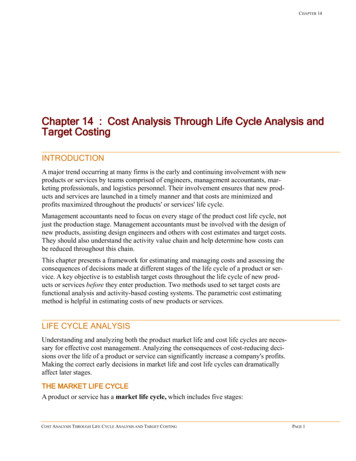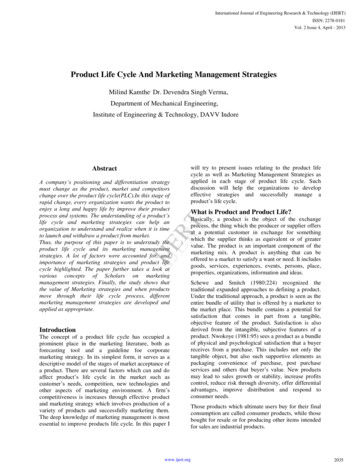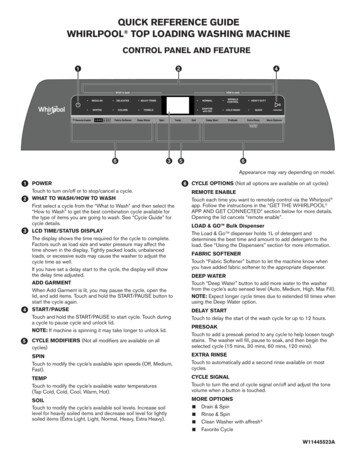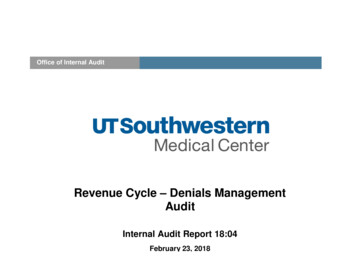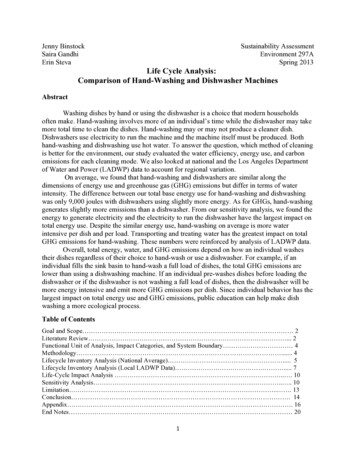
Transcription
Jenny BinstockSaira GandhiErin StevaSustainability AssessmentEnvironment 297ASpring 2013Life Cycle Analysis:Comparison of Hand-Washing and Dishwasher MachinesAbstractWashing dishes by hand or using the dishwasher is a choice that modern householdsoften make. Hand-washing involves more of an individual’s time while the dishwasher may takemore total time to clean the dishes. Hand-washing may or may not produce a cleaner dish.Dishwashers use electricity to run the machine and the machine itself must be produced. Bothhand-washing and dishwashing use hot water. To answer the question, which method of cleaningis better for the environment, our study evaluated the water efficiency, energy use, and carbonemissions for each cleaning mode. We also looked at national and the Los Angeles Departmentof Water and Power (LADWP) data to account for regional variation.On average, we found that hand-washing and dishwashers are similar along thedimensions of energy use and greenhouse gas (GHG) emissions but differ in terms of waterintensity. The difference between our total base energy use for hand-washing and dishwashingwas only 9,000 joules with dishwashers using slightly more energy. As for GHGs, hand-washinggenerates slightly more emissions than a dishwasher. From our sensitivity analysis, we found theenergy to generate electricity and the electricity to run the dishwasher have the largest impact ontotal energy use. Despite the similar energy use, hand-washing on average is more waterintensive per dish and per load. Transporting and treating water has the greatest impact on totalGHG emissions for hand-washing. These numbers were reinforced by analysis of LADWP data.Overall, total energy, water, and GHG emissions depend on how an individual washestheir dishes regardless of their choice to hand-wash or use a dishwasher. For example, if anindividual fills the sink basin to hand-wash a full load of dishes, the total GHG emissions arelower than using a dishwashing machine. If an individual pre-washes dishes before loading thedishwasher or if the dishwasher is not washing a full load of dishes, then the dishwasher will bemore energy intensive and emit more GHG emissions per dish. Since individual behavior has thelargest impact on total energy use and GHG emissions, public education can help make dishwashing a more ecological process.Table of ContentsGoal and Scope 2Literature Review . 2Functional Unit of Analysis, Impact Categories, and System Boundary 4Methodology . 4Lifecycle Inventory Analysis (National Average) . 5Lifecycle Inventory Analysis (Local LADWP Data) . 7Life-Cycle Impact Analysis . . 10Sensitivity Analysis . . 10Limitation . . 13Conclusion . 14Appendix . 16End Notes 201
Goal and ScopeThe goal of this analysis is to determine whether or not a dishwashing machine is moreenergy efficient and more water efficient than hand-washing dishes. Additionally, the analysisaims to see which process of cleaning dishes has a larger environmental impact, as measured bycarbon dioxide (CO2). Every time a household faces the choice of hand-washing or using adishwasher, the household impacts the environment. While the economic cost of investing in adishwasher is well documented, the environmental cost is not clear.The processes that can contribute to the environmental impact of hand-washing includethe water supply (transportation & treatment) and the gas used to heat the water. The processesthat can contribute to the environmental impact of dishwashers include the water supply(transportation & treatment), the gas to heat the water, electricity to run the dishwasher(electricity generation), and the manufacturing of the dishwasher. Since these inputs areregionally sensitive, we will look at the national average impact using the EIOLCA, and we willlook at a local impact based on the Los Angeles Department of Water and Power (LADWP). Thescope of this analysis does not include the inputs of soap and sponges. We estimate theenvironmental impact per dish from the sponge to be minimal as a sponge may be used for a longperiod of time. There was also limited information on sponge’s environmental effects.Additionally, both dishwashing machines and hand washing require the use of soaps.Environmental impacts resulting from soap use depends then not on which method of washing isused but rather on the type of soap an individual buys. Finally, we did not evaluate theenvironmental implications of sinks because it was assumed all households will have a kitchensink whereas that is not the case with a dishwasher.Literature ReviewSince the modern dishwasher entered the US consumer market in the 1950s,i it has beenmarveled as a time-saving addition to any household. Rather than washing your dishes by hand,the dishwasher offers the same service – all you need to do is load and unload the dishes.However, many have debated the dishwasher’s efficiency. Does it really save you time? Does ituse less water and energy? What are the environmental impacts? While looking throughliterature, it seems that using a dishwasher is the better choice. Modern dishwashers are highlywater and energy efficient making it difficult for hand-washing to compete. In fact, between1990 and 2005, dishwashers reduced energy use by 34% and reduced water use by 30%.iiFurthermore, studies show on average that a dishwasher produces a cleaner dish and saves time.iiiHand washing, on the other hand, does not require machinery and only uses energy toheat water. In Los Angeles, many homes use a gas heated water tank which may have a lowercarbon footprint than electricity grids. Some homeowners also invest in tank-less water heatersor solar water heaters which can further decrease the carbon footprint of heated water. Advocatesfor hand-washing dishes also mention space, mindfulness, and cleanliness as key reasons forchoosing to hand-wash.iv2
Today, 60-65% of American homes have a dishwasher.v As more households continue toinvest in dishwashers for the first time, or upgrade to newer energy efficient dishwashers, it isimportant to understand the total environmental impact of using a dishwasher or washing a dishby hand. At the University of Bond in Germany, a study recorded the hand washing methods ofresidents from seven European countries. This study was then replicated in other Europeancountries. Our study uses data from the German study, the UK study, and our own independentresearch. Overall, there is a large variation in how individuals wash dishes with no correlation toage, gender, or country of origin.vi Each participant washed 12 plate settings or 144 dishes(including pots, pans and cutlery). The water use, energy use, time and cleanliness were thencompared to the machine dishwasher averages. While on average, machine dishwashers wereshown as more efficient, an efficient hand-washer could beat the machine and a diligent handwasher could produce a cleaner dish.viiEnergy efficiency and water efficiency in dishwasher machines also have high levels ofvariation. The older your dishwasher, the more energy and water inefficient the dishwasher is.Dishwashers on the market today also vary in their efficiency levels and each dishwasher hasmultiple settings that also alter the dishwashing efficiency. To understand this variance, welooked at a “Summer Study on Energy Efficiency in Buildings” by the American Council for anEnergy Efficient Economy. The authors compared estimated energy use per cycle of 453dishwashers available in 2008 based on the Department of Energy (DOE) test procedure whichcombines machine energy use, water heating energy use, and drying energy use. The majority ofdishwasher models clustered around the energy star minimum requirement (with the averageefficiency being slightly more efficient than the Energy Star minimum).viii The authors thencompared the energy use of three specific modern dishwasher models: a Kenmore 665-1658220,Energy Star Kitchen Aid KUDS011 JBTI, and the most efficient dishwasher on the market in2008, the Bosch SHX98M09. Using the data for these three models, we analyzed the energyefficiency dishwashers use in various settings and inputs. These tests found that on average, thedishwashers could be used more efficiently than the tested settings under DOE guidelines. Thus,dishwashers when used on the most efficient settings use even less energy than reported withinuser manuals.ixHowever, most consumers do not follow factory recommendations when operating theirmachine dishwasher. According to a Virginia Tech survey, 93% of respondents pre-rinsed somedishes before loading the dishwasher.x Pre-rinsing can significantly add to the water and energyconsumption within a household. Manufacturers recommend scrapping food off dishes beforeloading the dishwasher, not pre-rinsing.xi Furthermore, new and top-of-the-line machinedishwashers have multiple levels that allow for more intensive washing of highly soiled dishesand some even have sensors to adjust energy and water use in comparison to the dishescleanliness.xii Despite these consumer options, many people continue pre-rinsing out of habit orcleanliness concerns.xiiiMost studies still recommend machine dishwashers because dishwashers are consistentlyshown to, on average, use less energy and water during the use-phase of the dishwasher.However, hand washing requires no machine production. To understand the full lifetimeenvironmental impact of dishwashing, it is important to look into the materials used to createdishwashers as well as the production process. According to Appliance Magazine, the use-phaseof dishwasher machines accounted for 90% of its primary energy consumption.xiv The3
production of the dishwasher accounted for 4,300 MJ of primary energy consumption comparedto 80,900 MJ of primary energy use during its use phase (assuming a lifetime of 15 years with300 cycles per year).xv The paper also asserted that the use-phase dominated with 95% of thetotal environmental burden. Unfortunately, this paper did not release its primary data collection,only aggregate numbers. The environmental impact of the dishwasher thus varies on the energysources for both the production and use phase. Since dishwashers are a global commodity, the4,300MJ of primary energy consumed in production may be from coal or other fuels with greatGlobal Warming Potential (GWP). At the same time, the sourcing for materials such as plastic,metals (steel), and even cotton may have unaccounted environmental impacts. For example, theauthors specifically site the cotton as an input with high environmental consequences due towater consumption for irrigation of cotton.xviAnother concern for dishwashers is its end of life. Once the appliance becomes waste, thedishwasher can be “separated into different material flows for reuse, recycling energy recoveryor disposal.”xvii However, our study did not find data for the energy use and environmentalimpact of this end of life treatment. According to the Appliance Magazine LCA, the primaryenergy use for dishwashers’ end of life treatment was less than 1% of its lifetime primary energyconsumption.xviii Thus, little attention was given to the topic. However, given the potentialenvironmental impacts from recycling electronic waste, we feel this is a subject that deservesfurther study.Functional Unit of Analysis, Impact Categories, and System BoundaryWe will use one dirty dinner-sized plate as our functional unit of analysis for our study.We will make appropriate conversions based on a full load of dishes an average dishwasher.From the study in Bonn University in Germany, we estimate that one full load is 12 placesettings. Each place setting has 12 pieces of dishes including bowls, plates, cutlery, pots andpans. Thus a full load is 144 dishes.xixThe impact categories that we examine are CO2 emissions, total water use, and total energy use.Our system boundary includes 2 stages of washing. We will exclude soap, sponges, and the sinkas inputs.Hand sherelectricitymanufacturing
MethodologyOur project used primary and secondary research to assess the energy, water, andgreenhouse gas emissions associated with washing dishes. We estimated water use when dishesare hand-washed by reviewing other studies and comparing those results to our project’s miniexperiment. The experiment had four trials in which three dishes were washed. To account forvariation in food’s adhesiveness, the experiment used four different meals and dishes werewashed immediately after the meal in two trials and washed hours later in the other two trials.Water use was measured by collecting the water with a bucket, while natural gas to heat thewater was measured using the equation:Joules mass * water specific heat * Celsius temperature changeThe results were averaged per dish. Our project also used dishwasher and manual handwashing studies as discussed in the literature review. This hybrid approach of combining primaryand secondary resources created a more thorough picture than either method alone could provide.Lifecycle Inventory Analysis (National Average)Manual Hand-WashingFor our base hand-washing scenario, we assumed washing was done with running water.This assumption was used because a study of manual dish-washing behavior in seven Europeancountries found there was no “typical” water-use behavior.xx There were not statisticallysignificant correlations between demographic dimensions like age, location, or gender andwhether a person filled a sink or left the water running. Since the project researchers washedtheir dishes with running water, we decided to err on the side of washing dishes with runningwater. Our base also assumed most households “cold” water is 15 C and was heated to 35 C.Thirty-five degrees was selected because the Australian government advised using temperaturessignificantly below 50 C to avoid scalding.xxiWe estimated how much households spend for the water and natural gas to wash a dishby averaging residential rates from across the country for water and natural gas supply. We thenplugged those figures into the EIOLCA tool to determine the energy associated with the wateruse and the greenhouse emissions generated with when transporting and heating the water. Moreinformation on the calculations is in the appendix.Phase 1Phase 2WaterHeated Water (35C)Water SupplyHand Washing Inputs (National)UnitsBase ValueWater Used (L)1.18Natural Gas (J) to Heat Water99161Energy (J) to distribute water8520Total GHG (tons)Total Energy5GHG Potential (tons)Included in phase 2.000002070.000008140.0000102107,681.00
Dishwasher:We made assumptions on the model, dishwasher size, water temperature, and productionin order to generate the base numbers below. Firstly, our base dishwasher was a 2008 dishwasherthat barely met the U.S. Department of Energy’s (DOE) dishwasher efficiency performancestandard. The DOE periodically sets energy standards which appliances must perform as well as,or better, than.xxii We used an inefficient dishwasher as a base because many households willhave older dishwashers since the appliances have a lifespan of approximately 15 years.xxiiiDishwashers have become more energy efficient over time,1 so an inefficient dishwasher willmore accurately reflect the energy use of older dishwashers than a more efficient dishwasher.Secondly, we assumed the dishwashers could hold 12 place settings and were fullyloaded when run. A place setting includes dinner plates, serving plates, glass tumblers, bowls,and silverware. The third assumption was that the water heater was set to 50 C. If water heaterswere set to a lower temperature, the dishwasher would require more electricity to heat the waterand run through the wash cycle.xxiv The assumptions were reflective of most households since itis standard to set water heaters to 50 Cxxv and for dishwashers to hold 12 place settings. xxviFinally, we determined energy and greenhouse gas emissions associated with dishwasherproduction using the EIOLCA tool -- Other Major Household Appliance Manufacturingcategory. Dishwasher prices range from 200 to 2,000,xxvii and we used a lower end price of 500 to reflect the likely price of the model analyzed in the base scenario. Energy and emissionswere divided by 15 (average lifespan of a dishwasher) and 300 (average loads per year). Theinputs below are per load. To get the per plate inputs, we divided the results by 144, the totalnumber of pieces of serving ware, per load. The assumption was that some dishes, like cups,may require more energy to clean than plates while pieces, like a spoon, may require less.Dishwasher InputsPhase1Water UseTemperature18.950Liters UsedBase Energy Use (J)Energy UsePhase2Base Liters UsedEnergy to RunDishwasher2,772,000Base Energy Use (J)GHG Potential (tons)Heated Water(Natural Gas)Energy to Heat Water2,767,716.00.0000582Water SupplyEnergy to Distribute theWater1,340,000.00.0001281Hoak, D., Parker, D., Hermelink, A., "How Energy Efficient are Modern Dishwashers", Proceedings of ACEEE2008 Summer Study on Energy Efficiency in Buildings, American Council for an Energy Efficient Economy,Washington, DC, August 2008.6
EnergySupplyEnergy to nufacturingEnergy to ManufactureDishwasher (Per Load)110.47.26667E-05Total GHG (tons)Per Load0.001090867Per Dish7.57546E-06Total Energy (J)16,769,826.40116457.1278Baseline Inventory Analysis ResultsAs shown in the table below, dishwashers use approximately 9,000 joules more energythan hand-washing. This is the result of more inputs like electricity to run the dishwasher andenergy to generate the electricity.Total Energy UsePhase 1Phase 2HWDWHWDWWater (L)1.180.13125J To HeatWater99,161.0019,220.25Energy (J)19,250J to SupplyWater8,5209,305.56Grand Total (J)J to GenerateElectricityn/a68,680.56HW DW J to ManufactureDishwasher110.40107,681.00116,566.76As shown below, dishwashers generate fewer greenhouse gas emissions than handwashing. The primary difference is that hand-washing uses more water which createsgreenhouse gas emissions from the water distribution and the energy to heat the water.Greenhouse Gas Emissions (Kg)Water (L)Phase nd Total (Kg)HWDW0.01020.0076To Heat WaterWater SupplyHW0.00205DW0.000404167Phase 2Our base comparison of hand-washing a dish with running water versus an 2008 energyinefficient dishwasher in normal wash and full load found that dishwashers use slightly moreenergy ( 9,000 joules 0.0025 kWH), use less water per dish, and generate .0026 kilogramsfewer greenhouse gas emissions than hand-washing.Lifecycle Inventory Analysis (Local LADWP Data)7
We selected data from the Los Angeles Department of Water and Power (LADWP) forthis portion of our analysis, which serves as a case study of regional variance over water andenergy use. LADWP not only serves as a highly relevant example as a local and large utilitycompany, but may also provide interesting insight into the energy associated with moving waterlong distances as LADWP does.In order to perform our local LCA inventory, we knew we needed data on the following:proportion of energy consumed by residential customers (as we are looking at home’s water use),the amount of energy used to supply the water, and the GHG emissions associated with energysupplied by LADWP. We found all of this data available in the LADWP’s most recent 2010“Urban Water Management Plan,” which is updated every five years. The following annual datafor 2009 was extracted from this report:LADWP Data Used for Local LCA Inventory (2009)Total Volume Delivered (AF)562,480Total Energy Intensity (kWh/AF)1,934Total Carbon Footprint (tons CO2)433,698Total Energy (kWh)1,087,836,320Total Residential Energy (kWh)445,577,757Table extracted from “Urban Water Management Plan” LADWP, 2010.xxviiiWe used this data to calculate the following numbers and make the following conversions to usein our LCA inventory analysis for local numbers:LADWP Energy and GHG Emissions Intensity Ratios for kWh and Liters of Water UsedEnergy use associated with transport of water (total.0016 kWh/LkWh/AF, converted to L)GHG emissions associated with transport of water.00000063 tons CO2/L(total GHG emissions/AF, converted to L)GHG emissions associated with energy use (total.0010 tons CO2/kWhGHG emissions/residential kWh)Lastly, in order to calculate the energy and GHG emissions associated with heating waterin a water tank to wash dishes by hand, we used the same base numbers as the national numbersfor kWh used to heat water to 90 degrees Fahrenheit using natural gas. We used the samenumbers for both dishwashing and hand washing as in the national scenario. In order to calculatethe GHG emissions associated with using natural gas to heat water, we converted data from theUS Environmental Protection Agency (EPA) to learn that natural gas emits approximately.000198 tons of CO2 per kWh.xxixLCA Inventory for Hand Washing – One Clean DishFor hand-washing, we used the same base numbers as in the national inventory (.028kWH of natural gas used to heat 1.185L of water to 35 degrees Celsius; 1.185L of waterconsumed by washing dishes by hand). We also used LADWP GHG ratios and energy intensityratios for both liters of water transported and kWhs consumed to determine the total energy use8
and GHG’s emitted for this process. The total energy used by this system is 106,001 J per dish,and the total tons of CO2 per dish are .0000081. Our results are shown in the following diagram:LADWP Hand-washing Inventory AnalysisLCA Inventory for a Dishwasher – One Clean Load of DishesFor the dishwasher, we used most of the same base numbers as in the national LCAinventory (.77 kWH of natural gas used to heat 18.9L of water to 35 degrees Celsius; 18.9L ofwater consumed by a dishwasher). Again, we used the LADWP GHG ratios and energy intensityratios for both liters of water transported and kWhs consumed to determine the total energyconsumed and GHG’s emitted by a dishwasher to clean one load of dishes. To find the electricityto create the energy to run the machine, we used the same energy ratio (3.57) as found throughthe EIOLCA. The total energy used by this system is 106,001 J per load of dishes, and the totalCO2 are .004 tons per load of dishes. Our results are shown in the following diagram:LADWP Dishwasher Inventory Analysis9
Life-Cycle Impact AnalysisOver the course of one year, a family doing 300 loads of 12 settings would use 1,292kWH if washing by hand and 1,397 kWH using a dishwasher. That family would saveapproximately 12 a year with those energy savings.2 Overall, the dishwasher’s energy use isonly marginally higher than washing by hand, and dishwashing behavior does not have a bigimpact on a family’s energy use or expenses.Total Energy (J)Per Dish(dinner dish)Per Load(12 settings)Per Year(300 Loads per Year)HW107,681.0015,506,064.004,651,819,200.00 J 1,292.2 kWHDW116,457.1316,769,826.405,030,947,920.00 J 1397.5 kWHManual dish washing generates 113 kg more greenhouse gas emissions than a dishwasherover the course of a year. This is roughly the emissions released from using 13 gallons ofgasoline when driving.3xxxTotal GHGEmissions (kg)HWDWPer Dish(dinner dish)0.01020.0076Per Load(12 settings)1.471.09Per Year(300 Loads per Year)440.21327.26Sensitivity AnalysisWe conducted sensitivity analyses using the SensIt excel formulas to determine whichinputs have the biggest impact on hand washing and dishwashing energy use and greenhouse gasemissions. We used the base figures described above and varied the figures by 10% in eitherdirection for the minimum and maximum values.Manual Hand-washingWith hand-washing, the total energy use is most sensitive to the input of energy to heatthe water. The water source also contributes to total energy use but to a much smaller degreethan the energy to heat the water.2 12 105kWH* kg/gallonofgasoline 12.5gallons.310
000TotalEnergy(J)PerDishHand-washing greenhouse gas emissions are most sensitive to emissions from the waterdistribution and 0.01120.0114TotalGHGEDishwasherOur dishwasher sensitivity analysis looked at all inputs to a dish cleaned by a dishwasher.Total dishwasher energy use and greenhouse gas emissions are most sensitive to the inputs ofenergy to generate electricity and electricity to run the dishwasher. The energy to run thedishwasher is influenced by the dishwasher setting and water temperature. Water probably has asmaller overall influence on energy use and greenhouse gas emissions because dishwashers areless water-intensive than hand-washing.11
As dishwashers become more energy efficient, electricity to run the dishwasher mayinfluence total energy use less over time. Additionally, whether energy comes from dirtiersources or from more efficient production will have a big impact on dishwashers total energy useand greenhouse gas emissions.DishwasherSensi-vityAnalysis- PerDishDishwasherSensi-vityAnalysis- DishVarying Hand-washing and Dishwasher InputsA follow-up consideration was whether varying hand-washing techniques or dishwashermodels and settings would change the story. Our base numbers found the two approaches12
roughly equivalent on energy use and found hand-washing generated more greenhouse gasemissions.Varying Hand-washing InputsOne study found water use per dish as low as 0.3 liters when the dish was washed in afilled sink, rather than with running water. With such a practice, manual dish-washing emitsfewer greenhouse gas emissions at temperature range of cold (15 C) to hot (35 C). With runningwater, manual hand-washing is more greenhouse gas intensive than a dishwasher however. Evenwhen the running water is unheated at 15 C, it emits 0.008 kg of emissions which is higher thana dishwasher’s 0.0076 kg. This means the hand-washing in only cleaner than a full dishwasherwhen the dish is washed with other dishes in a filled sink basin. See appendix for more details oncalculations and figures.Varying Dishwasher InputsBy varying the dishwasher setting and model year, the dishwasher can use less energy orgenerate more greenhouse gas emissions than our base manual hand-washing example. Thedishwasher used less energy than hand-washing with a light wash setting, rather than normalwash setting. Conversely, the dishwasher emitted more greenhouse gas emissions than handwashing with a heavy wash setting in a 2008 model and with a normal wash in a 1993dishwasher. Most households will have a newer dishwasher than a 1993 model, given that theiraverage lifespan is 15 years.xxxi With a light wash setting, a fully-loaded dishwasher withoutprewashing is “greener” than hand-washing along energy and greenhouse gas emissiondimensions. A dishwasher is dirtier than hand-washing with the heavy wash setting or use of adishwasher from 1993.Future studies should consider examining prewashing behavior, dishwasher loads, and abroader range of dishwasher model years. A future study could examine how many dishes peopleprewash and whether households run partially filled dishwashers. Data on these inputs may meandishwashers use even more energy and emit more greenhouse gas emissions than manual handwashing.LimitationsWe chose ultimately to focus on the water and energy usage associated with handwashing and dishwashers. This meant that we made choices to omit several inputs from ouranalysis, and make specific choices about how we would examine energy and water data.InputsInitially, we considered examining three additional inputs for our study: dish soap andsponges (hand washing) and dish detergent (dish washers). Our initial research failed to identifyany publicly available life cycle assessment studies for these inputs. In the absence of soap life13
cycle LCA studies, we performed research into the toxicity of both hand washing dish soap anddishwasher detergent to learn what key ingredients in the products had the most substantialenvironmental impacts. However, when we discovered that toxicity varied across products, andthat individual products were applied differently, we found the varying qualities made dish soapsand detergents too complicated to include given the scope of and timeframe available for ourstudy. Furthermore, we learned that phosphates are typically the most toxic component of soaps.In the past years, many states have passed laws limiting the ph
Life Cycle Analysis: Comparison of Hand-Washing and Dishwasher Machines Abstract Washing dishes by hand or using the dishwasher is a choice that modern households often make. Hand-washing involves more of an individual's time while the dishwasher may take more total time to clean the dishes. Hand-washing may or may not produce a cleaner dish.

